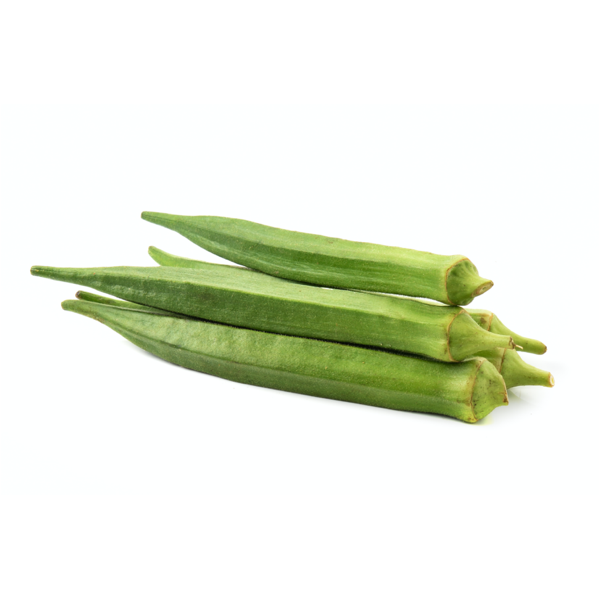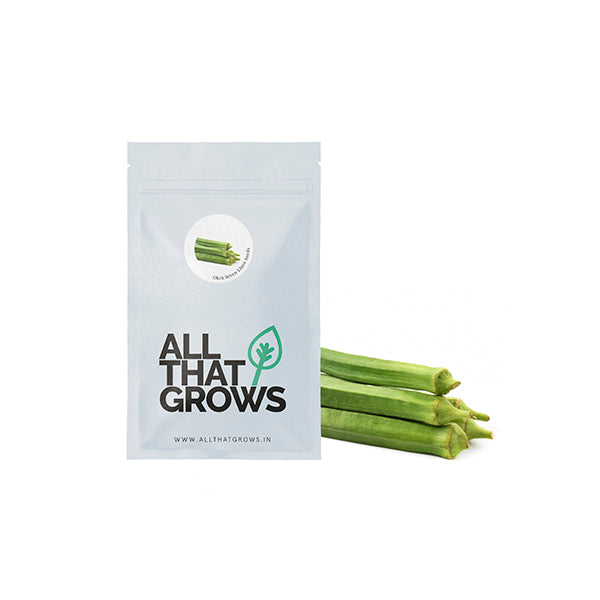



Okra Seven Lines Seeds
Grow this with
Seed Type : Non-Hybrid, Open Pollinated and Non-GMO
Plant type : Plants well branched
Sowing time : January to March (summers)
Fruit characters : Light green, slightly thick, 5-6 inches, 7 ridged,tender
Harvesting : After 45-50 days from sowing
- SOWING
TIMEJanuary to March (summers)
- Sowing
DistancePLANT TO PLANT 12'' LINE TO LINE 18''
- Fruit
WeightN/A
- Fruit
Shapelong with 7 ridges
- Days to
maturity45-50 days
- Details
- How to sow
- Reviews
First cultivated in Africa, Okra popularly traveled from there to America and South Asia and became a much-loved summer vegetable. Grown usually in tropical and sub-tropical weather conditions, Okra has a gummy texture and belongs to the Malvaceae family of flowering plants. Okra is also one of the most heat and drought resistant vegetable. It is full of life-sustaining nutrients and minerals such as Vitamin A, B6, C, K, dietary fiber, folate, potassium, calcium, magnesium, and iron. Eating Okra, rich in so many health-giving nourishing substances, is a great way to have healthy cholesterol levels, maintain weight, prevent the risk of developing colorectal cancer, have a strong immune system, as well as protect the eyesight and body tissues. Though not in abundance but the ladyfinger does carry small quantities of protein, carbohydrate, and almost negligible calories too. These also have plenty of antioxidants such as beta-carotene, xanthin, and lutein and can also help in keeping the heart healthy and reduces the chances of being afflicted with type 2 diabetes monumentally.
In India, Okra is cooked in a variety of ways. Fried, stuffed or cooked simply after cutting in equal sized pieces with spices. Okra contains oxalates that can cause kidney and gallstone conditions to worsen, as the oxalates bond with existing stones and cause them to grow. Therefore Okra should be avoided in the case of stone conditions.
Planting instructions
Okra seeds are tough to transplant, therefore, it is recommended to plant them directly from seeds. In a warm climate region, you can easily sow the seeds in the garden where the soil temperature is between 25°C to 35°C.
Sow the seeds about 1 inch deep in the soil. Keep the distance between each plant between 12 to 18 inches. Each row should be at least 3 ft apart. Keeping the soil moist after sowing the seeds helps significantly in the germination process.
The seeds should germinate within 2 to 10 days depending upon the temperature. It is advisable to soak the seeds overnight before sowing since this will help in accelerating the germination process.
Growing Requirements
Pests & Diseases
Pests: Aphids, Armyworms, Corn Earworm, Cucumber Beetles, Loopers, Thrips, Root-Knot Nematode, Spider Mites. Diseases: Charcoal Root, Fusarium Wilt, Powdery Wilt, Southern Blight, White Mold, Enation Leaf Curl Disease, Yellow Vein Mosaic Disease. Watering the plants in the morning helps to avoid fungal diseases. Companion plants significantly reduce incoming pests on your crops. Watering down the plants with a strong stream of water followed by an application of diluted neem or castor oil on the pest-affected parts of the plant will help to get rid of them.
soil
Nutrient-rich, fertile, well-drained soil with a pH level of 6.5 to 7.0.
spot
Full sun; Okra plants need at least 6 hours of sunlight in a day.
Temperature
The ideal germination temperature for okra falls between 25°C to 35°C.
watering
Keep the okra plants well hydrated. But, do not wet the foliage. It’s best to water okra plants in the early hours of the morning. Also, applying a thick layer of mulch will help your okra plants to retain the moisture in the soil for a longer period of time.
how to harvest
You would be able to see okra pods on the plants in a mere 8 weeks after planting the seeds. Usually, it only takes 4 days for an okra flower to mature into a fruit. Harvest the okra pods when they are at least 2-3 inches long.
Cut the pods using scissors where the stems meet the branches of the plant. It is advisable to wear gloves when you harvest okra pods since the leaves and pods can cause irritation to your skin. Harvesting everyday or every other day during the peak season will encourage the growth of more fruits.
Chop-off the lower leaves to increase the production of fruits after the first harvest. Just like all other vegetables, Okra can also be stored in the refrigerator for later use. Simply wrap them in a paper towel and store them in the vegetable drawer of your refrigerator.

Customer Reviews
The productiveness of any seed we sell is subject to your local climatic conditions*, the sowing method you adopt, and your commitment to the planting process. We give no warranty, expressed or implied, and are in no way responsible for the produce.
Please note that all our seasonal recommendations/ sowing information is as per the local climatic conditions. *For more information on the optimum conditions required for growing seeds in your region, please contact us at, hello@allthatgrows.in or Whatsapp us at, +91 8544865077
Questions & Answers
Have a Question?
Be the first to ask a question about this.




Okra Seven Lines Seeds
Seed Type : Non-Hybrid, Open Pollinated and Non-GMO
Plant type : Plants well branched
Sowing time : January to March (summers)
Fruit characters : Light green, slightly thick, 5-6 inches, 7 ridged,tender
Harvesting : After 45-50 days from sowing
Grow this with
First cultivated in Africa, Okra popularly traveled from there to America and South Asia and became a much-loved summer vegetable. Grown usually in tropical and sub-tropical weather conditions, Okra has a gummy texture and belongs to the Malvaceae family of flowering plants. Okra is also one of the most heat and drought resistant vegetable. It is full of life-sustaining nutrients and minerals such as Vitamin A, B6, C, K, dietary fiber, folate, potassium, calcium, magnesium, and iron. Eating Okra, rich in so many health-giving nourishing substances, is a great way to have healthy cholesterol levels, maintain weight, prevent the risk of developing colorectal cancer, have a strong immune system, as well as protect the eyesight and body tissues. Though not in abundance but the ladyfinger does carry small quantities of protein, carbohydrate, and almost negligible calories too. These also have plenty of antioxidants such as beta-carotene, xanthin, and lutein and can also help in keeping the heart healthy and reduces the chances of being afflicted with type 2 diabetes monumentally.
In India, Okra is cooked in a variety of ways. Fried, stuffed or cooked simply after cutting in equal sized pieces with spices. Okra contains oxalates that can cause kidney and gallstone conditions to worsen, as the oxalates bond with existing stones and cause them to grow. Therefore Okra should be avoided in the case of stone conditions.
Seed Type : Non-Hybrid, Open Pollinated and Non-GMO
Plant type : Plants well branched
Sowing time : January to March (summers)
Fruit characters : Light green, slightly thick, 5-6 inches, 7 ridged,tender
Harvesting : After 45-50 days from sowing
- SOWING
TIMEJanuary to March (summers)
- Sowing
DistancePLANT TO PLANT 12'' LINE TO LINE 18''
- Fruit
WeightN/A
- Fruit
Shapelong with 7 ridges
- Days to
maturity45-50 days
Planting instructions
Okra seeds are tough to transplant, therefore, it is recommended to plant them directly from seeds. In a warm climate region, you can easily sow the seeds in the garden where the soil temperature is between 25°C to 35°C.
Sow the seeds about 1 inch deep in the soil. Keep the distance between each plant between 12 to 18 inches. Each row should be at least 3 ft apart. Keeping the soil moist after sowing the seeds helps significantly in the germination process.
The seeds should germinate within 2 to 10 days depending upon the temperature. It is advisable to soak the seeds overnight before sowing since this will help in accelerating the germination process.
Growing Requirements
Pests & Diseases
Pests: Aphids, Armyworms, Corn Earworm, Cucumber Beetles, Loopers, Thrips, Root-Knot Nematode, Spider Mites. Diseases: Charcoal Root, Fusarium Wilt, Powdery Wilt, Southern Blight, White Mold, Enation Leaf Curl Disease, Yellow Vein Mosaic Disease. Watering the plants in the morning helps to avoid fungal diseases. Companion plants significantly reduce incoming pests on your crops. Watering down the plants with a strong stream of water followed by an application of diluted neem or castor oil on the pest-affected parts of the plant will help to get rid of them.
soil
Nutrient-rich, fertile, well-drained soil with a pH level of 6.5 to 7.0.
spot
Full sun; Okra plants need at least 6 hours of sunlight in a day.
Temperature
The ideal germination temperature for okra falls between 25°C to 35°C.
watering
Keep the okra plants well hydrated. But, do not wet the foliage. It’s best to water okra plants in the early hours of the morning. Also, applying a thick layer of mulch will help your okra plants to retain the moisture in the soil for a longer period of time.
how to harvest
You would be able to see okra pods on the plants in a mere 8 weeks after planting the seeds. Usually, it only takes 4 days for an okra flower to mature into a fruit. Harvest the okra pods when they are at least 2-3 inches long.
Cut the pods using scissors where the stems meet the branches of the plant. It is advisable to wear gloves when you harvest okra pods since the leaves and pods can cause irritation to your skin. Harvesting everyday or every other day during the peak season will encourage the growth of more fruits.
Chop-off the lower leaves to increase the production of fruits after the first harvest. Just like all other vegetables, Okra can also be stored in the refrigerator for later use. Simply wrap them in a paper towel and store them in the vegetable drawer of your refrigerator.



 Sign In
Sign In








